Bonsai Trees
Case Histories
Trident Maple - (acer buergerianum)
Trident Maple Bonsai Style: Root over Rock
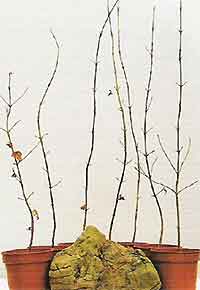
Whilst visiting a bonsai nursery one spring day I noticed a very large and impressive root over rock trident maple, which had recently been imported from Japan. I had never seen a bonsai tree growing over such a large rock. The roots were old and gnarled, gripping the rock tightly. I studied the tree for several minutes until I realised that all was not as it seemed. Some branches were fully in leaf, others only partially leafed and several were not in leaf at all.
Even stranger was that the leaf sizes, shapes and colours varied from branch to branch. The bonsai was in fact several trees combined together to create the illusion of one tree.
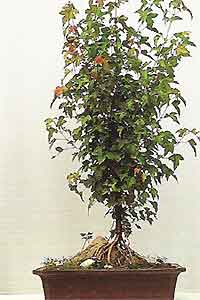
Without leaves the bonsai would be completely convincing as a single tree and was a truly magnificent specimen. I could not imagine why the creator of this bonsai had not selected the material more carefully, so that leaf size and shape were better matched.
Trident Maple Bonsai History: Training
This trident maple was often in my thoughts and the inspired idea of using separate trees as roots. Indeed, I noticed several more examples of the method at different bonsai nurseries and exhibitions.
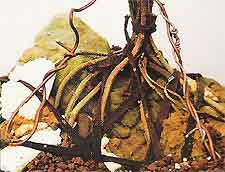
This was obviously an alternative technique for creating root over rock trees and the idea appealed to me! That summer I selected seven trident maple seedlings that had identical leaves in all aspects and I eagerly waited for spring to arrive.
I remembered that I had found a very interesting rock several years previously and had always planned to plant a tree over it, but the opportunity had never arisen - until now!
Finally spring arrived and I set to work. The trident maple seedlings were two years old and very pliable. I spent a long time carefully positioning the trunks around the rock, as if they were the roots of a single tree.
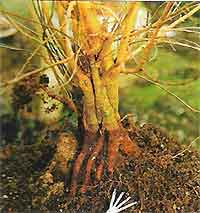
The seedlings were then tied tightly to the rock with string, which would eventually rot away. I did not use wire as it would have cut into the roots very quickly and scarred them. The trees were bound together with raffia just above the rock, to form one single trunk and then my new potential bonsai was planted in a large bonsai pot with the rock showing its best side to the front.
During the summer the trees grew strongly and were fed regularly. When autumn arrived the leaves changed colour together and appeared to be identical hues, so I was pleased that I had selected suitable seedlings. One year after its creation I was happy that the project looked promising, but I now needed to accelerate the growth. The trees and rock were therefore planted in the garden, with the rock being below ground level. After less than a year since its creation, some of the saplings had begun to fuse together and one overall trunk was beginning to form.
Remaining in the ground for the next four years, the trees continued to grow well and reached 2 metres (over 6 feet) in height. The only maintenance carried out at this stage was occasional pruning of the trunks and branches to create taper. Also each spring I mulched heavily with rotted horse manure.
The trunks had now formed a definite unity and I was anxious for the trees and 'roots' not to thicken any more, so that the rock would still appear to be in proportion. I nervously dug up the tree in late winter, not knowing quite what to expect. I had not seen the rock for over four years and was apprehensive as I carefully removed the soil from around the rock, with a fork.
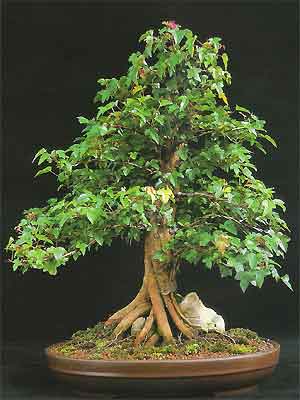
I was pleasantly surprised at the convincing 'roots' that had been created by the trees and washed the remaining soil from the roots with a hose pipe to expose them better. After much deliberation I decided to use the previous back of the trees as the front! The roots looked more realistic from that angle and the rock still looked reasonable.
Two of the trunks had not grown as well as the rest and still remained separate, so these were carefully joined to the main trunk with screws, to ensure a good, close contact. I reduced the height by over three quarters and completely pruned off all heavy branches, leaving many fine shoots. The 'tree' was planted in a large oval pot and the thicker roots pruned hard, leaving plenty of fibrous roots. I wired the remaining small shoots and positioned them to create the branches of this one tree. At last, after over five years, a root over rock bonsai tree was beginning to emerge.
The tree leafed out well and began to look impressive. I let it grow freely for the first few months to help it recover and regain its strength and then pruned to create a basic structure. I find it hard when looking at the bonsai to remember that it is actually made up of seven completely separate trees and now I only see one tree, with a secret that no-one will ever guess!
 Whilst visiting a bonsai nursery one spring day I noticed a very large and impressive root over rock trident maple, which had recently been imported from Japan. I had never seen a bonsai tree growing over such a large rock. The roots were old and gnarled, gripping the rock tightly. I studied the tree for several minutes until I realised that all was not as it seemed. Some branches were fully in leaf, others only partially leafed and several were not in leaf at all.
Whilst visiting a bonsai nursery one spring day I noticed a very large and impressive root over rock trident maple, which had recently been imported from Japan. I had never seen a bonsai tree growing over such a large rock. The roots were old and gnarled, gripping the rock tightly. I studied the tree for several minutes until I realised that all was not as it seemed. Some branches were fully in leaf, others only partially leafed and several were not in leaf at all. Without leaves the bonsai would be completely convincing as a single tree and was a truly magnificent specimen. I could not imagine why the creator of this bonsai had not selected the material more carefully, so that leaf size and shape were better matched.
Without leaves the bonsai would be completely convincing as a single tree and was a truly magnificent specimen. I could not imagine why the creator of this bonsai had not selected the material more carefully, so that leaf size and shape were better matched. This was obviously an alternative technique for creating root over rock trees and the idea appealed to me! That summer I selected seven trident maple seedlings that had identical leaves in all aspects and I eagerly waited for spring to arrive.
This was obviously an alternative technique for creating root over rock trees and the idea appealed to me! That summer I selected seven trident maple seedlings that had identical leaves in all aspects and I eagerly waited for spring to arrive. The seedlings were then tied tightly to the rock with string, which would eventually rot away. I did not use wire as it would have cut into the roots very quickly and scarred them. The trees were bound together with raffia just above the rock, to form one single trunk and then my new potential bonsai was planted in a large bonsai pot with the rock showing its best side to the front.
The seedlings were then tied tightly to the rock with string, which would eventually rot away. I did not use wire as it would have cut into the roots very quickly and scarred them. The trees were bound together with raffia just above the rock, to form one single trunk and then my new potential bonsai was planted in a large bonsai pot with the rock showing its best side to the front. I was pleasantly surprised at the convincing 'roots' that had been created by the trees and washed the remaining soil from the roots with a hose pipe to expose them better. After much deliberation I decided to use the previous back of the trees as the front! The roots looked more realistic from that angle and the rock still looked reasonable.
I was pleasantly surprised at the convincing 'roots' that had been created by the trees and washed the remaining soil from the roots with a hose pipe to expose them better. After much deliberation I decided to use the previous back of the trees as the front! The roots looked more realistic from that angle and the rock still looked reasonable.